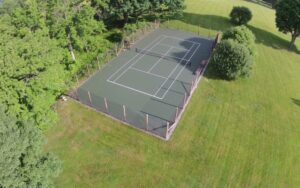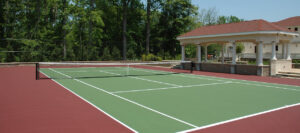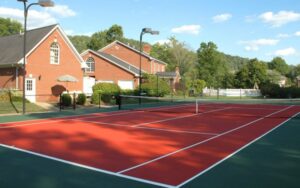 Have you been thinking about having a tennis court installed in your backyard? Classic Turf Company can make that happen… but first, here’s some information about all the things to consider when planning your court construction…
Have you been thinking about having a tennis court installed in your backyard? Classic Turf Company can make that happen… but first, here’s some information about all the things to consider when planning your court construction…
Ample Space
First, do you have the room for it? A regulation-sized tennis court for doubles play measures 60 by 120 feet. Of course, you will need additional room around it for drainage, landscaping and fencing.
The space where your tennis court will ultimately go needs to be reasonably level– and, if possible, it should be on the same plane (or higher) than adjacent land. There needs to be a proper slope to allow water to drain away from your court. For sites that have a high water table, an underground drainage system might need to be installed. Before anyone digs anything, it’s a good idea to have the soil tested– you want to make sure the soil underneath the planned court surface is stable. Also, put a court where there aren’t trees/tree roots that would try and mess with it.
If your court will be used often during daylight hours, consider having it installed in a north-south orientation, keeping in mind the extremes of early morning and late afternoon sun angles.
 Selecting the Right Service
Selecting the Right Service
Surface-wise, tennis courts have been done in dirt, grass, clay and concrete, among other materials. We recommend Classic Turf’s post tension concrete option, which includes a 20-year crack-free guarantee. Traditionally, court surfaces are green in color. The darker the surface color the better ball visibility you’ll have. Dark court surfaces reduce sun glare, too.
The Right Accessories
Besides the tennis court surface, some other things to choose include a fence around the court, windscreens, shade structures, a scorekeeping unit, hitting walls (for practice), and lighting if you want to play at night. Additionally, most owners like to make their tennis court area look especially nice with landscaping, which might include bushes, shrubs, trees and other features.
Tennis Fencing
When you’re deciding what kind of fencing to have installed for your backyard court, you’ll want a fence that’s 10 feet tall. You can talk with your installer about different fencing options, asking about chain link, fabric mesh and other styles.
Shade and/or Wind Shelter
If the area where your court will be placed gets a lot of direct sun and you want a shade shelter, those usually consist of a concrete/paver slab, metal framework and a fabric awning. There are factory-built options which mount on your court or fence. Court-mounted shelters typically include a bench to sit on.
Is your backyard generally windy? If so, you should get a windscreen, which is typically made of vinyl-coated fabric.
Hitting Wall
Oftentimes homeowners like to have a hitting wall installed with their tennis court, which gets the ball back to them easily if no one else is around to play. A hitting area is a place to warm up for a game and/or practice repetitive strokes. Should your court have an exposed retaining wall, that can double as a hitting wall.
 Tennis Court Lighting
Tennis Court Lighting
With lighting a court, the main thing to worry about is not bothering neighbors. Nothing’s worse than having a neighbor mad at you because your outdoor lighting is shining into their bedroom too brightly, keeping them up at night. Thankfully, specialized tennis court lighting is designed to shine light right on the court without illuminating the areas outside the court. FYI: court lights are generally mounted about 20 feet above the court surface.
Actual Tennis Court Installation
When you’re ready to discuss having a tennis court installed in your backyard, please don’t hesitate to call Classic Turf Company at 1-800-246-7951. Since there are plenty of details that go into the making of a court, you’ll want to ask lots of questions and get lots of answers. The main topics to discuss are: permits needed to build the court, preparing the terrain, installing the court, adding lighting (or not), and what kind of landscaping around the court needs to be done. If and when you choose to have a court installed, the process includes the surveying of land, as well as levelling, clearing and the excavation of soil. Cables, slabs, and fence posts are key things used in putting together a court, as well as the pouring of concrete. Ask your installer to give you an overview of what will happen and when it will happen if you’re curious about the whole process.
Whether you’re an athlete or not, or you have friends/family members who enjoy a game of tennis, one thing’s for sure: a backyard tennis court can be a fun asset on your property– the kind of thing that sets it apart from other people’s properties. Instead of having to go somewhere to practice or play tennis, having your own backyard court is so convenient and a point of pride!

 Selecting the Right Service
Selecting the Right Service Tennis Court Lighting
Tennis Court Lighting